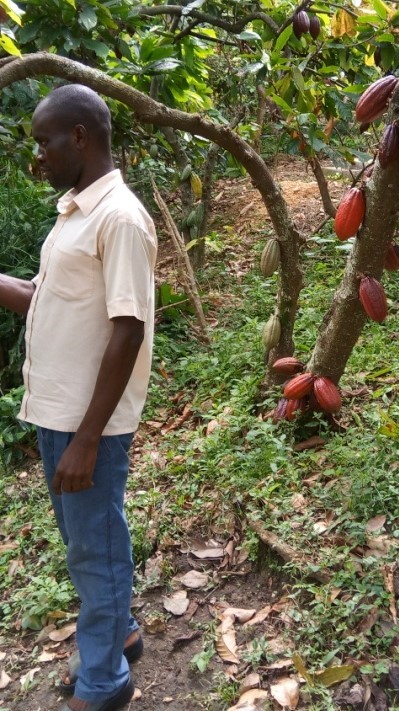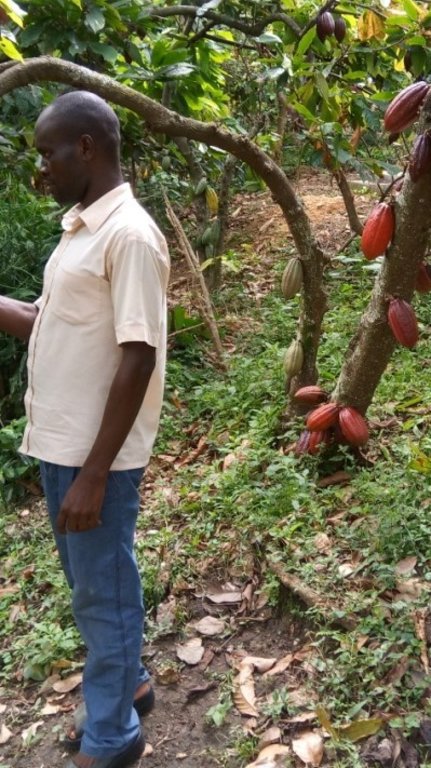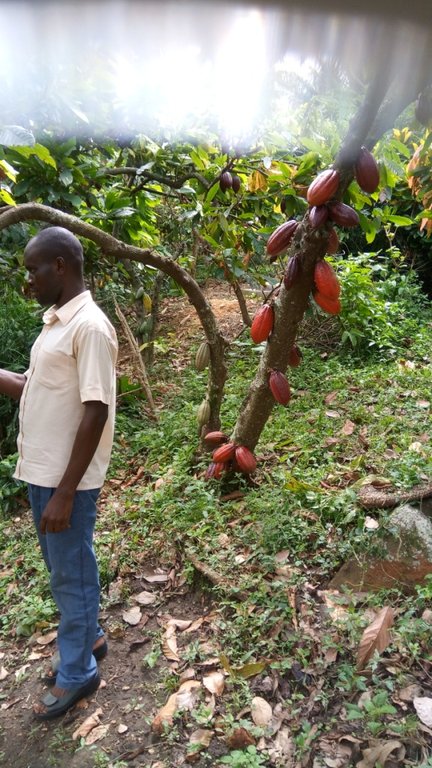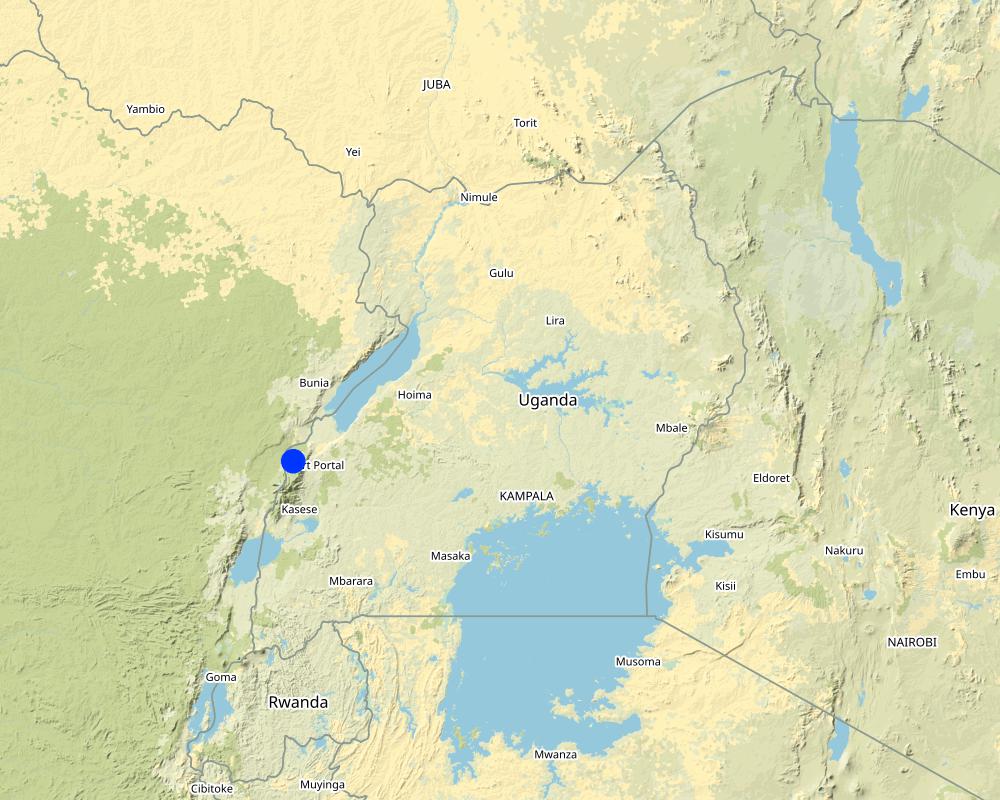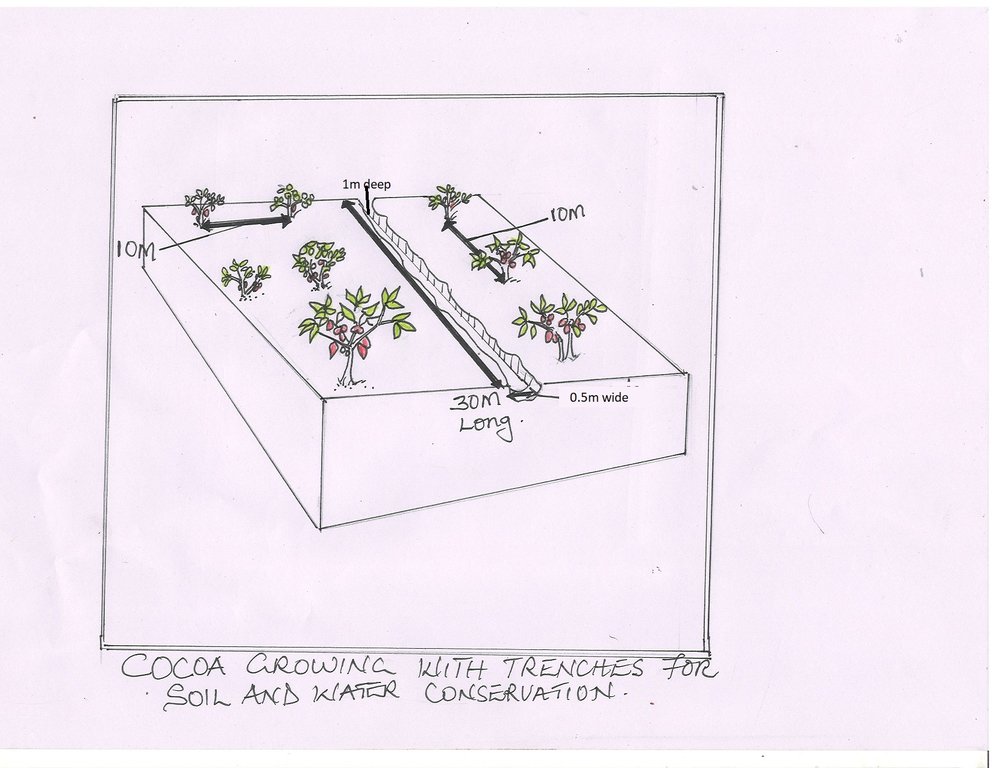Trenches in a Cocoa Plantation for Soil and Water Conservation [Uganda]
- Creation:
- Update:
- Compiler: Sarah Babirye
- Editor: Kamugisha Rick Nelson
- Reviewers: Nicole Harari, Luigi Piemontese, Udo Höggel
COCOA
technologies_3309 - Uganda
View sections
Expand all Collapse all1. General information
1.2 Contact details of resource persons and institutions involved in the assessment and documentation of the Technology
Key resource person(s)
land user:
Mugume Isaac
Name of project which facilitated the documentation/ evaluation of the Technology (if relevant)
Scaling-up SLM practices by smallholder farmers (IFAD)Name of the institution(s) which facilitated the documentation/ evaluation of the Technology (if relevant)
National Agricultural Research Organisation (NARO) - Uganda1.3 Conditions regarding the use of data documented through WOCAT
When were the data compiled (in the field)?
14/10/2017
The compiler and key resource person(s) accept the conditions regarding the use of data documented through WOCAT:
Ja
1.4 Declaration on sustainability of the described Technology
Is the Technology described here problematic with regard to land degradation, so that it cannot be declared a sustainable land management technology?
Nee
Comments:
If the technology is well practiced, it promotes soil and water conservation in a cocoa plantation.
2. Description of the SLM Technology
2.1 Short description of the Technology
Definition of the Technology:
Trenches commonly referred to as contour trenches and running perpendicular to a slope increase water infiltration and reduce soil erosion as a way of conserving soil.
2.2 Detailed description of the Technology
Description:
Farmers today face a lot of problems in practicing agriculture and one of them is soil erosion. In hilly areas like Bundibugyo, soil and water runoff is reported to be of paramount importance to farmers growing cocoa on steep slopes. To counteract the problems associated with such cultivation farmers have come up with a strategy of constructing contour trenches. Contour trenches are dug structures, perpendicular to the slopeline, of a certain depth and width in a field of any kind. In this way runoff soil, together with run-off water is caught in such structures and thereby, kept on the field.
In this plantation, the technology reduces water runoff, increases water infiltration and also improves soil fertility. As reported by a cocoa farmer, trenches should be dug in dry season. The numbers of trenches in the plantation depends on the size and the slope of the land. Normally in an acre, 10-15 trenches can be constructed. On establishment of these trenches in hilly area, they are 1m deep, 0.5m wide and 30m long on average along horizontal contour lines. Necessary materials to construct these trenches include a measuring tape, ropes, spades, and hoes.
The soils can be stabilized such that they are not washed into the trenches again. Some grasses are therefore planted on the sides of the trenches. After allocating suitable places for trenches, labour is locally available. However, some farmers who grow cocoa don’t want to dig trenches because it is laborious and requires larger land sizes.
Management is relatively cheaper as it only involves, emptying the trenches periodically.
2.3 Photos of the Technology
2.4 Videos of the Technology
Date:
17/10/2017
Name of videographer:
Sarah Babirye
2.5 Country/ region/ locations where the Technology has been applied and which are covered by this assessment
Country:
Uganda
Region/ State/ Province:
Western Region
Further specification of location:
Bundibujo District
Map
×2.6 Date of implementation
If precise year is not known, indicate approximate date:
- more than 50 years ago (traditional)
2.7 Introduction of the Technology
Specify how the Technology was introduced:
- as part of a traditional system (> 50 years)
3. Classification of the SLM Technology
3.1 Main purpose(s) of the Technology
- improve production
- reduce, prevent, restore land degradation
- reduce risk of disasters
- adapt to climate change/ extremes and its impacts
3.2 Current land use type(s) where the Technology is applied

Cropland
- Perennial (non-woody) cropping
Main crops (cash and food crops):
Cocoa
Comments:
In hilly areas, trenches are dug to reduce the speed of running water. This is a way of maintaining soil fertility by keeping water and soil in the field.
3.3 Further information about land use
Water supply for the land on which the Technology is applied:
- rainfed
Comments:
The area receives much rainfall of over 1500mm-2500mm. Being a hilly area, there is a lot of soil erosion.
Number of growing seasons per year:
- 2
Specify:
March and August
3.4 SLM group to which the Technology belongs
- improved ground/ vegetation cover
- integrated soil fertility management
- water harvesting
3.5 Spread of the Technology
Specify the spread of the Technology:
- evenly spread over an area
If the Technology is evenly spread over an area, indicate approximate area covered:
- 0.1-1 km2
3.6 SLM measures comprising the Technology

agronomic measures
- A1: Vegetation/ soil cover
- A2: Organic matter/ soil fertility

structural measures
- S2: Bunds, banks
- S7: Water harvesting/ supply/ irrigation equipment
3.7 Main types of land degradation addressed by the Technology

soil erosion by water
- Wt: loss of topsoil/ surface erosion
- Wg: gully erosion/ gullying
- Wo: offsite degradation effects

biological degradation
- Bc: reduction of vegetation cover
3.8 Prevention, reduction, or restoration of land degradation
Specify the goal of the Technology with regard to land degradation:
- prevent land degradation
- reduce land degradation
4. Technical specifications, implementation activities, inputs, and costs
4.1 Technical drawing of the Technology
4.2 Technical specifications/ explanations of technical drawing
Trenches are normally established during the dry season on small pieces of land usually an 1 acre.
Slopes range from 16 -30 % in areas with high rainfall. The dimension of the trenches are 1m deep, 0.5m wide and 30m long.
4.3 General information regarding the calculation of inputs and costs
Specify how costs and inputs were calculated:
- per Technology area
Indicate size and area unit:
0.5-1 acre
Indicate exchange rate from USD to local currency (if relevant): 1 USD =:
3600.0
Indicate average wage cost of hired labour per day:
10000/=
4.4 Establishment activities
| Activity | Type of measure | Timing | |
|---|---|---|---|
| 1. | Identify areas which are prone to soil erosion | Other measures | During dry seosons and after strong rains |
| 2. | Get tools and labour | Other measures | During dry seseons |
| 3. | Define the size of the trench | Management | In dry seseons |
| 4. | Dig standard trenches (30m) long | Structural | In dry seseon |
| 5. | Remove soil that has been washed into the trenches | Management | After strong rains |
Comments:
Establishment activities are mostly done by family labour or hired labour.
4.5 Costs and inputs needed for establishment
| Specify input | Unit | Quantity | Costs per Unit | Total costs per input | % of costs borne by land users | |
|---|---|---|---|---|---|---|
| Labour | Digging trenches | persons | 15.0 | 10000.0 | 150000.0 | 100.0 |
| Equipment | Hiring a hoe | piece | 1.0 | 1000.0 | 1000.0 | 100.0 |
| Equipment | Hiring a slasher | piece | 1.0 | 1000.0 | 1000.0 | 100.0 |
| Equipment | Hiring a spade | piece | 1.0 | 1000.0 | 1000.0 | 100.0 |
| Equipment | Hiring a wheel barrow | piece | 1.0 | 10000.0 | 10000.0 | 100.0 |
| Total costs for establishment of the Technology | 163000.0 | |||||
If land user bore less than 100% of costs, indicate who covered the remaining costs:
All costs are covered by the land user.
Comments:
The initial costs are cost-efficient compared to returns. Planting materials like elephant grass planted on the downslope sides of the trenches can be obtained freely.
Total costs for establishing trenches are slightly expensive. However, maintenance costs are comparatively low.
4.6 Maintenance/ recurrent activities
| Activity | Type of measure | Timing/ frequency | |
|---|---|---|---|
| 1. | Clearing trenches after long rains | Management | Every after heavy rains |
Comments:
Most of these management activities are done after strong rains.
4.7 Costs and inputs needed for maintenance/ recurrent activities (per year)
| Specify input | Unit | Quantity | Costs per Unit | Total costs per input | % of costs borne by land users | |
|---|---|---|---|---|---|---|
| Labour | Clearing trenches after rains | Man day | 15.0 | 10000.0 | 150000.0 | 100.0 |
| Total costs for maintenance of the Technology | 150000.0 | |||||
Comments:
This cost is estimated but could even be less. This makes the technology easily adopted by all cocoa farmers in hilly areas.
4.8 Most important factors affecting the costs
Describe the most determinate factors affecting the costs:
Labour as some farmers cannot meet all costs.
5. Natural and human environment
5.1 Climate
Annual rainfall
- < 250 mm
- 251-500 mm
- 501-750 mm
- 751-1,000 mm
- 1,001-1,500 mm
- 1,501-2,000 mm
- 2,001-3,000 mm
- 3,001-4,000 mm
- > 4,000 mm
Specify average annual rainfall (if known), in mm:
1500.00
Agro-climatic zone
- humid
5.2 Topography
Slopes on average:
- flat (0-2%)
- gentle (3-5%)
- moderate (6-10%)
- rolling (11-15%)
- hilly (16-30%)
- steep (31-60%)
- very steep (>60%)
Landforms:
- plateau/plains
- ridges
- mountain slopes
- hill slopes
- footslopes
- valley floors
Altitudinal zone:
- 0-100 m a.s.l.
- 101-500 m a.s.l.
- 501-1,000 m a.s.l.
- 1,001-1,500 m a.s.l.
- 1,501-2,000 m a.s.l.
- 2,001-2,500 m a.s.l.
- 2,501-3,000 m a.s.l.
- 3,001-4,000 m a.s.l.
- > 4,000 m a.s.l.
5.3 Soils
Soil depth on average:
- very shallow (0-20 cm)
- shallow (21-50 cm)
- moderately deep (51-80 cm)
- deep (81-120 cm)
- very deep (> 120 cm)
Soil texture (topsoil):
- coarse/ light (sandy)
Soil texture (> 20 cm below surface):
- medium (loamy, silty)
Topsoil organic matter:
- high (>3%)
5.4 Water availability and quality
Ground water table:
5-50 m
Availability of surface water:
medium
Water quality (untreated):
poor drinking water (treatment required)
Is water salinity a problem?
Nee
Is flooding of the area occurring?
Nee
5.5 Biodiversity
Species diversity:
- high
Habitat diversity:
- high
5.6 Characteristics of land users applying the Technology
Sedentary or nomadic:
- Sedentary
Market orientation of production system:
- commercial/ market
Off-farm income:
- less than 10% of all income
Relative level of wealth:
- poor
Individuals or groups:
- individual/ household
Level of mechanization:
- manual work
Gender:
- men
Age of land users:
- middle-aged
5.7 Average area of land owned or leased by land users applying the Technology
- < 0.5 ha
- 0.5-1 ha
- 1-2 ha
- 2-5 ha
- 5-15 ha
- 15-50 ha
- 50-100 ha
- 100-500 ha
- 500-1,000 ha
- 1,000-10,000 ha
- > 10,000 ha
Is this considered small-, medium- or large-scale (referring to local context)?
- small-scale
5.8 Land ownership, land use rights, and water use rights
Land ownership:
- individual, not titled
Land use rights:
- individual
Water use rights:
- individual
5.9 Access to services and infrastructure
health:
- poor
- moderate
- good
education:
- poor
- moderate
- good
technical assistance:
- poor
- moderate
- good
employment (e.g. off-farm):
- poor
- moderate
- good
markets:
- poor
- moderate
- good
roads and transport:
- poor
- moderate
- good
drinking water and sanitation:
- poor
- moderate
- good
financial services:
- poor
- moderate
- good
6. Impacts and concluding statements
6.1 On-site impacts the Technology has shown
Socio-economic impacts
Production
crop production
Comments/ specify:
Cocoa plantations with trenches increased the quantity in production as moisture is retained.
land management
Comments/ specify:
Soil degradation can be significantly reduced.
Income and costs
diversity of income sources
Comments/ specify:
Besides other activities, farmers earn a lot from cocoa growing
Ecological impacts
Water cycle/ runoff
surface runoff
Comments/ specify:
Water surface run off is reduced
Climate and disaster risk reduction
flood impacts
Comments/ specify:
Trenches reduce the run off of water thereby reducing on-site and off-site erosion impact.
6.2 Off-site impacts the Technology has shown
downstream flooding
Comments/ specify:
Water runoff is reduced by trenches.
downstream siltation
Comments/ specify:
Water runoff is reduced by trenches.
6.3 Exposure and sensitivity of the Technology to gradual climate change and climate-related extremes/ disasters (as perceived by land users)
Climate-related extremes (disasters)
Hydrological disasters
| How does the Technology cope with it? | |
|---|---|
| flash flood | very well |
Biological disasters
| How does the Technology cope with it? | |
|---|---|
| epidemic diseases | moderately |
6.4 Cost-benefit analysis
How do the benefits compare with the establishment costs (from land users’ perspective)?
Short-term returns:
positive
Long-term returns:
positive
How do the benefits compare with the maintenance/ recurrent costs (from land users' perspective)?
Short-term returns:
positive
Long-term returns:
positive
Comments:
Maintenance costs of the trenches are comparatively low.
6.5 Adoption of the Technology
- more than 50%
Of all those who have adopted the Technology, how many have did so spontaneously, i.e. without receiving any material incentives/ payments?
- 90-100%
6.6 Adaptation
Has the Technology been modified recently to adapt to changing conditions?
Ja
If yes, indicate to which changing conditions it was adapted:
- climatic change/ extremes
Specify adaptation of the Technology (design, material/ species, etc.):
Making more trenches in the cocoa growing areas.
6.7 Strengths/ advantages/ opportunities of the Technology
| Strengths/ advantages/ opportunities in the land user’s view |
|---|
| Improve on production in areas where technology is applied |
| Restore land degraded |
| Improves on soil fertility |
| Strengths/ advantages/ opportunities in the compiler’s or other key resource person’s view |
|---|
| Restores degraded land at a lower costs |
| Improves livelihood among farmers |
| With trenches, the soils are always moist providing suitable conditions for the growth of the crop |
6.8 Weaknesses/ disadvantages/ risks of the Technology and ways of overcoming them
| Weaknesses/ disadvantages/ risks in the land user’s view | How can they be overcome? |
|---|---|
| Establishing trenches is expensive | Involve group work |
| Sometimes making trenches is tiresome hence it may be difficult for ladies to do | Involving hired labour |
| Weaknesses/ disadvantages/ risks in the compiler’s or other key resource person’s view | How can they be overcome? |
|---|---|
| Requires much labor for making trenches | Involve hired labour |
| Trenches alone cannot solve soil degradation | Apply grasses along the trenches like calliandra and elephant grass among others |
| Trenches are always filled up with soil during water run off hence making it expensive to clear all the time | Always make deeper and wider trenches that can accomodate big volumes of sediments and water |
7. References and links
7.1 Methods/ sources of information
- field visits, field surveys
4
- interviews with land users
1
7.2 References to available publications
Title, author, year, ISBN:
Environmental impacts of Cocoa production and processing in Ghana :Life cycle assessment approach by Augustine Ntiamoah,2008
Available from where? Costs?
http://www.cocoaconnect.org/sites/default/files/publication/Environmental%20impact%20of%20cocoa%20life%20cycle%20assessment.pdf
Links and modules
Expand all Collapse allLinks
No links
Modules
No modules


